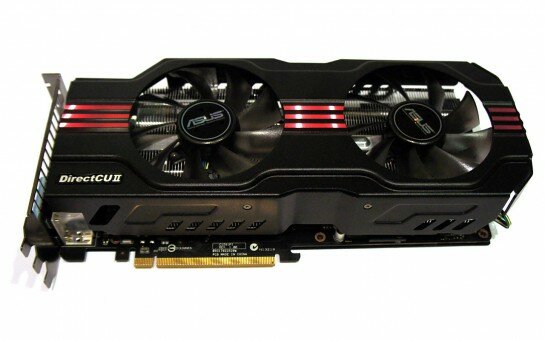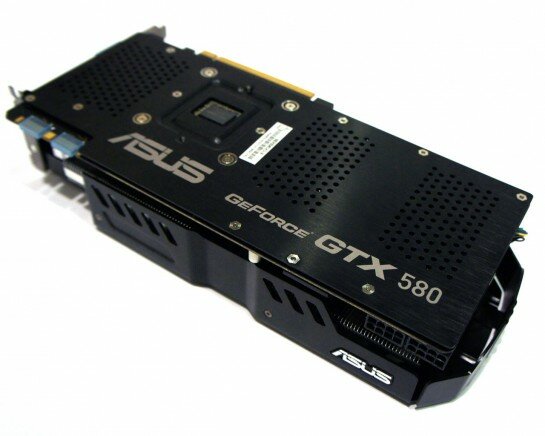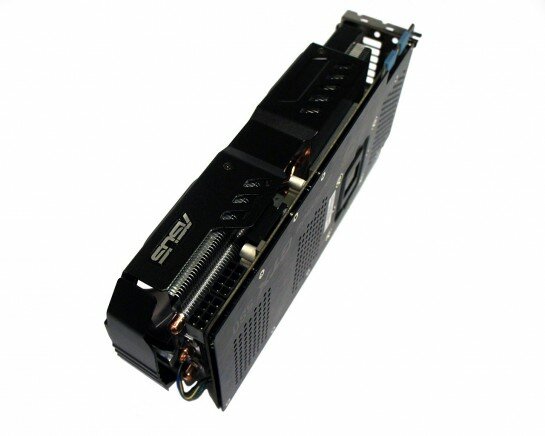Overclocking the ASUS GeForce GTX 580 DirectCU II
Having previously unboxed this big, super-fast boy, I borrowed the card off Suds (why thank you kind Sir!) and took it home to test the overclocking.
Borrow a suped-up GTX 580 you say? Yes, it’s times like this I really do enjoy my job.
The Voltage Tweak hardware can be, well, ‘tweaked’ using the included SmartDoctor software that comes on the boxed CD. Failing that, you can just download it from the ASUS website too. It’s a simple case of just increasing the sliders to the level of awesome we want the card to run at, before testing it with some FurMark and 3DMark, and, if I’m honest, several hours of Civilisation V too..*ahem*.

Triple-slot, customised and now, heavily overclocked: I make no apologies for torturing you, Mr. GeForce GTX 580 DirectCU II
Cranking that little blue slider on the screen I hit 919MHz core frequency at 1.1V, with a 4.2GHz (effective) GDDR5 frequency. This is stable enough to run games all day everyday. Pushing it to 925MHz at 1.113V would work for long enough to commit a benchmark run, but unfortunately not always longer term. Adding more voltage would not appear to help us improve stability either. The actual voltage increment in SmartDoctor goes to a huge 1.38V so there’s clearly some legs left in the PCB design, but I expect it the core on our card has unfortunately hit its limit (outside of extreme cooling, which would also do well on this card!)
I decided to use the customisable fan-speeds in the SmartDoctor software in order to crank up the fan according to the slowly rising temperature. The software gives four levels of fan speed, which I set to 50, 60, 70 and 80C respectively. The GPU limit is a toasty ~120C so there’s plenty of legs left in it if you wanted to keep it quieter. Despite TSMC working the transistor magic with Nvidia on its GF110 GPU core on the GeForce GTX 580, it’s still a big, hot, 3 billion transistor chip. This means even a bigger cooler like the DirectCU II with its two, massive fans it still gets hot. Normally the fans automatically run below 2,000RPM keeping the card virtually silent, however start cranking up the juice and the heat output will always increase significantly, meaning the fan speed has to inevitably rise as well. The DirectCU II tops out at 3,300RPM and trust me when I say this shifts some serious air to keep things cool!
Running it through 3DMark Vantage, I got a GPU score for the ‘Performance’ and ‘High’ presets at 925MHz/4.2GHz was 28,888 and 20705 respectively. Not bad, but if you have your own please let us know your OC results as well!
Feel free to drop any comments below.





Nick Holland
Nick Holland – Portability and PC gaming are essential to Nick’s life. He’s enjoyed the latter since a very young age – eschewing consoles for customizability of a PC (with the finest backbones like the Asus P3B-F and A7V133) and the feel of a keyboard and mouse. As soon as he could afford a notebook he got one and things have rolled on from there into sleek DTRs (desktop replacements) netbooks, smartphones and he’s already eyeing up the latest tablets while trying to think up an excuse to own one. After writing about all things tech for several years it is only natural he sought to join the already awesome TiS team.